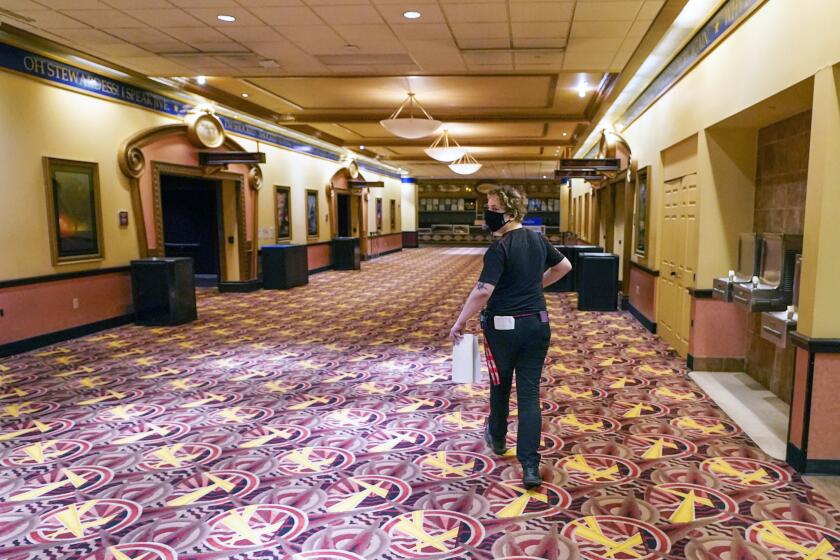Opinion: Just ask Taylor Swift: Data make the case for movie theaters versus streaming

- Share via
The rise of streaming platforms has forced Hollywood to question everything — and the uncertainty grows more urgent now that the strikes are over and film projects are resuming. Recent research points toward some answers.
We studied IMDb user review data from the two years leading up to the COVID-19 pandemic and found that for 86% of major nationally released movies, people generally enjoyed watching the film in a theater more than they would have at home. The research, conducted with our colleague Jason Ho, showed that the difference was greatest for big-budget and franchise films — apparently best enjoyed on big screens, surrounded by fellow fans, free from the distractions of life.
Studios should come to the rescue by buying up chains and revolutionizing the screening side of the industry.
Hollywood should take note and work closely with theaters, because they are still key to supporting the industry. Theaters meet a need for consumers and bring in revenue that streaming-only releases do not.
Maybe one reason people enjoy theatrical screenings is they’re more likely to watch with friends or a date, with whom they can discuss the film afterward. Perhaps spending a premium to see a movie in person, and planning ahead, predisposes people to savor the experience.
Taylor Swift seems to get it: She released her Eras tour film to theaters in mid-October rather than to streamers, even though those companies would have bid aggressively to get the first release rights. This move extended the in-person experience of the concerts themselves by creating a shared experience for the first wave of people watching the film. (“Taylor Swift: The Eras Tour” racked up $123.5 million at the box office globally in its opening weekend.) Beyoncé is following the same strategy for her concert film “Renaissance,” to be released in theaters Friday.
TV and movie actors were on strike for 118 days. Now they have until Dec. 5 to ratify a new contract that could help keep us all from being digitally replaced.
Hollywood studios face double trouble when they release films online at the same time as in theaters, or very soon after. The first toll is lower box-office revenue, which is still key to most films’ financial success. The second price studios pay is subtler. Our research found that if the first viewers are on streaming platforms, the reviews would be worse than if the first viewers are all in theaters. Previous research had found that the earliest reviews of a movie have a particularly strong influence on its box-office performance.
Streaming viewers are likely to rate a film less positively, because they might be doing the dishes or jogging or commuting as they half-watch the film. How can that compare with sitting back in a theater, with your phone silenced and snacks in your lap?
The strikes by writers and actors have cost the entertainment industry and the local economy billions of dollars. The deal should help ensure actors can continue to make a living.
Studios can experience the vicious cycle of a streaming release, which hurts reviews, which hurts box-office sales and subsequent streaming interest. Or they can choose the virtuous cycle of an “only in theaters” release, which supports strong early reviews, which supports further box-office sales and, eventually, interest on streaming platforms.
Not that it’s all about money. Similar logic applies when studios and filmmakers are mounting campaigns for Oscar nominations and other awards. They could do much more to encourage voters to see a movie in a theater, such as creating events in areas where voters live and work. Or look to make deals with major theater chains, to create nationwide events with special screenings of Oscar contenders with the aim of creating buzz. (This sort of deal between studios and theaters was illegal for decades but is now possible again.)
Theater owners need no encouragement to pursue a big-screen strategy. But they should still pay attention and act shrewdly to maintain their advantage over streaming platforms. Our research does not explain why viewers rate a movie seen in a theater higher than when seen on a streaming service. That’s a great question for theater owners — to find out why and then enhance those features even further. To the extent that enjoyment of a movie depends upon luxury seating, superior video and audio, and special effects, theater owners should consider charging higher prices for such features, as some already do. Theater chains’ marketing can also be tailored to remind consumers that they will enjoy a movie more at a theater.
Theaters ought to have a strong tailwind from the trend among streaming platforms to interrupt content with ads. Our data on streaming enjoyment were based on ad-free content. Now that commercials are making a comeback on the small screen, viewers may be more receptive to theaters’ appeal.
It’s possible that none of this will reverse the long-term decline in theater attendance and revenue in the U.S., but it can help to avoid further decline and keep the theater experience alive for future generations. On behalf of those of us who like going to the movies, we hope so.
Jehoshua Eliashberg, Charles B. Weinberg and Berend Wierenga are professors emeriti of marketing at the University of Pennsylvania, the University of British Columbia and Erasmus University in Holland.
More to Read
A cure for the common opinion
Get thought-provoking perspectives with our weekly newsletter.
You may occasionally receive promotional content from the Los Angeles Times.













